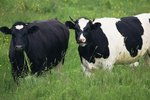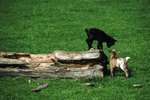Things You'll Need
Cattle chute
Tetanus shot
Banamine or Flunixen shot
Elastrator
Bands
Dehorning calves can be gruesome, especially when the horns are cut out. The American Veterinary Medical Association, better known as the AVMA, has asked farmers to to start giving local anesthetics while dehorning. The AVMA has also issued a statement saying that banding of horns or buds has been associated with long-term chronic pain, rather than the pain of cutting them off. When cattle have horns they run the chance of hurting each other or you. Breeding for polled cattle is another option, meaning they are born without horns.
Run your cattle in a corral and herd them towards your cattle chute. Get the calf that you want to dehorn set with its head locked in the chute, and the back panels shutting him in.
Give the calf an intramuscular injection for tetanus. Tetanus is a deadly infection also known as lockjaw. It comes from puncture wounds and other open wounds. Also give the calf a shot of Banamine, which is known generically as flunixen. This, too, can be given in the muscle and will help with inflammation and pain.
Place the bands, using an elastrator that will stretch the band down and around the horn, and into the hairline. Make sure the bands fit tightly all the way around the hairline.
Let the calf go once the bands are on both horns. Watch the calf over the next month. Within a month the horns should start to fall off.
Bring the calf back into the chute once the horns have fallen off. The wounds need to be sprayed with fly repellent antiseptic during the healing process.
Warnings
Open wounds will attract flies and maggots. Avoid dehorning calves in the heat of summer when insects are numerous.
References
Photo Credits
-
Digital Vision./Digital Vision/Getty Images





